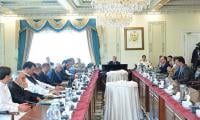KARACHI: Pakistan’s economy is expected to get up to two percent boost as the multibillion dollars Chinese-funded energy projects are increasing production capacity to do away with power deficit of 5,000 megawatts, a foreign bank’s official said on Thursday.
“There are various estimates of the impact on GDP, but we expect at least a 1.5-2 percent improvement if the power shortage is addressed,” Arslan Nayeem, Standard Chartered Head of Global Banking in Pakistan said in a report, assessing the impact of China-Pakistan Economic Corridor (CPEC) projects.
“Three to five years ago, a lack of power was one of corporates’ prime concerns; now that’s being addressed to a great degree with enough projects coming online.”
China initiated $62 billion of projects under the CPEC framework and the figure is equivalent to 21 percent of Pakistan’s GDP.
Standard Chartered Pakistan said an additional 9,000 megawatts are scheduled to be added by the middle of this year, increasing capacity by 50 percent.
“Although plans to end load-shedding by 2018 haven’t come to pass, scheduled outages in main cities have halved in recent years as new capacity has come online,” the bank said in the report, titled “Sustainability Review 2018”.
Around two-thirds of the scheduled CPEC investment will be in 21 power plants, three in a bid to end a supply deficit of around 5,000MW.
China’s Three Gorges Corporation is planning three hydropower projects in north-eastern Pakistan with a combined investment of $5.7 billion with a planned total capacity of 1,118MW. The first of these - the Kohala hydropower project - will come online in 2020. Kohala is due to be transferred to Pakistan after 30 years of operation “The economic boost from additional power capacity is a clear benefit,” the bank’s official said. “For the power sector, there is also the question of how problems with distribution and utilisation can be addressed, even as capacity is increased.”
The bank said concerns have been raised about the nature of Chinese investment and the debt loads incurred in concessional loans to finance construction.
“But a shift in the nature of Chinese involvement in such projects suggests the partnership is focused on long-term success.”
Standard Chartered Senior Economist Bilal Khan said there is an issue of servicing the return requirements of Chinese asset owners when the projects are up and running.
“In the first 10 years, it will be about servicing debt; beyond that guaranteed return-on-equity [contracts] means operators will also be sending dividends and profits back to China,” Khan says. “Pakistan will have to make foreign exchange available for that, at the rate of between $1 billion-2.5 billion per year, depending on how much capacity comes online.”
The bank said trade routes and developing Gwadar Port are focus points of CPEC, “thanks to Pakistan’s geographic position at the epicentre of trade corridors from Western China to the Middle East, Africa and Europe, which in theory could make it the nexus of some $2.5 trillion of trade flows. “But it also encompasses a range of infrastructure investments to bolster the business environment, including power generation.”
Chinese investment is not confined to power projects, but it also expanded to road and infrastructure development, boosting steel and cement manufacturing industries.
Pakistan was the world’s fastest-growing steel producer in 2017, with crude steel output up nearly 40 per cent from 2016. Cement production has also been rising steadily and was up 14.7 per cent year-on-year by end-March 2018.
“Our clients in the steel and cement industries are contemplating expansion because they see the opportunity for growth,” Nayeem added.
The headquarters of the Sui Southern Gas Company . — APP FileKARACHI: Sui Southern Gas Company has launched a fresh...
The logo of the ExpoMed Eurasia. — CA MI websiteKARACHI: Pakistan is participating in ExpoMed Eurasia, a leading...
Gold bars are seen in this undated file photo. — AFP/FileKARACHI: Gold prices increased by Rs500 per tola on...
FFBL Head Office building can be seen in Islamabad. — FFBL WebsiteKARACHI: Fauji Fertilizer Bin Qasim Limited has...
Representational file of an BMW car. — AFP FileLAHORE: Small improvements in economic credentials of the country are...
A fuel station worker filling petrol in vehicle at a fuel station in Karachi on Tuesday, April 16, 2024KARACHI: After...







